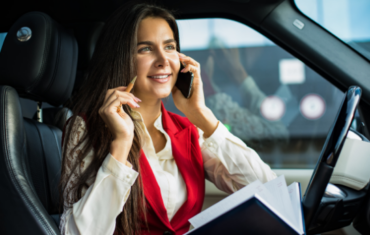“Never let the future disturb you. You will meet it, if you have to, with the same weapons of reason which today arm you against the present.”—Marcus Aurelius
If you’re new to sales or if you own a business looking to better understand how to predict the growth of your company, the words of philosopher and emperor Marcus Aurelius might claim the anxiety you feel about sales forecasting. To get it right, you need the right weapons of reason or, in this case, the right methods of forecasting and formulas to help you.
Every industry is a little different, and for those working in the real estate and title industry, the variables that affect the market seem endless. Don’t let the unknown paralyze you.
Here are some ways to get started in sales forecasting.
Sales Forecasting for Real Estate and Title Companies
You know that there are key sales metrics you should be monitoring on a regular basis, but those metrics alone won’t predict your monthly, quarterly, or annual sales.
All sales forecasting is about managing the consequences of being wrong, and there’s a lot that can go wrong when predicting sales in the housing market. However, there is no reason to fear. By understanding and implementing the right methods for your business, area, and goals, you can minimize risks.
Your entire company will benefit from sales forecasting. The operations team will be able to make critical decisions related to hiring and investments in new tools to meet a sustainable and growing number of real estate deals and title orders.
For some businesses, the right formula for success is pretty straightforward and there is little seasonality. For title agents and other real estate professionals, the housing market is influenced by a multitude of factors, even international news like the coronavirus has impacted overseas real estate investment, resulting in lower mortgage rates in the United States.
Additionally, if you plan to ever sell or merge your title company or real estate business, a potential buyer or investor will want to see a history of accurate sales forecasts.
Thinking of selling your title business? Watch our on-demand webinar!
Getting Started with Sales Forecasting
Before you get started, you’ll want to create the right team, understand the process, and examine market dynamics.
Build Your Team
Sales forecasting is a systematic process that involves various business functions. Typically, your sales team will be involved but other departments that need to be aligned with the forecast include:
- Operations
- Finance
- Marketing
Finance has historical data related to past expenses and sales results. These numbers are important for getting started in quantitative forecasting.
The marketing department can share insights on market trends, current marketing strategies, buyer behavior, audience targeting, and brand perception. These details will provide insights on the likelihood of converting prospects into clients.
Operations have a deeper understanding of your clients’ ordering patterns and customer sentiment. Their day-to-day interactions will clients give them an instinct that almost resembles clairvoyance on what’s likely to come.
The Sales Forecasting Process
After you’ve assembled your team, be sure that everyone understands their role and keep them in the loop. Next, take the following steps:
- Analyze the market – What category are you in? How big is your market? What are the trends and dynamics affecting future outcomes?
- Collect Data – Get the relevant data for the forecast. In some cases, you may have to make assumptions in lieu of sufficient data to get started.
- Decide on your sale forecasting technique – Sales forecasting can be divided into two categories, qualitative and quantitative. Decide if you will use one or both of these methods. Sometimes what data you have available will dictate the method.
- Test your model – Run the model through past sales cycles to see how well it performs and fine-tune for errors.
Examine Market Dynamics
If you’ve been in the real estate or title industry for some time, you probably know what factors impact the outcome of your sales instinctually even if you aren’t tracking all the numbers. There are obvious common trends that affect the housing market, like those looking to move in the new year will settle on the best discounts for buyers in December or how springtime is met with flowers popping up on front lawns along with more “For Sale” signs.
You know your target market, so take time to dive even deeper into the other factors that may impact each category of homebuying, lending, investing, and refinancing trends.
Some other market dynamics to look at include:
- New offerings from your competitors
- Mortgage rates
- Mergers and acquisitions of underwriters, homebuilders, title companies and other key real estate players
- Regulatory changes like CCPA
- Election results
- Consumer behaviors and sentiments
- Job market growth in your area
- New build starts or permitting in your area
- Changes in technology like Remote Online Notarization
Additionally, consider any internal changes in your business like operation strategy changes, changes in leadership, and marketing or advertising initiatives that may influence your forecasting numbers.
Qualitative vs. Quantitative Forecasting
The best sales forecasters rely on these two forecasting techniques:
- Qualitative
- Quantitative
Qualitative techniques rely on less concrete factors like customer feedback and expert insights. Use qualitative techniques that lean on expert insights if you lack historical data. For companies with data on past sales, quantitative techniques give more reliable output and concrete numbers. However, that’s only true if the historical data you rely on is clean. Dirty data yields dirty forecasts that can cost your company dearly.
Qualitative Forecasting
If you have little historical data to go off of, qualitative forecasting is a good place to start. Some of those methods include:
- Expert panels
- The Delphi Method
- Sales representative’s feedback
Panel of Experts
The real estate industry and subsequently the title industry is heavily influenced by various economic factors like job growth, demographic trends of homebuyers, consumer confidence, and interest rates, as well as political and regulatory factors at the state and federal level. As a result, expert insights can help reduce forecasting errors.
Find people who will have a diverse and unique perspective of the real estate market. For title companies or real estate law firms, your panel will most likely be comprised of:
- Lenders
- Realtors
- Homebuilders from a homebuilding company or association
- Real Estate Investors
After deciding on what experts you’ll invite for comments, you’ll have to decide what sort of information you need. For example, do you want to know how many mortgage originations lenders expect throughout the US, your state, or in a specific market? Do you want to know what portion is expected to be resales, new sales, and refinances? Do you want annual, quarterly, or monthly numbers of originations?
Each question will depend on your business goals. If you’ve decided to invest in new technology and training to increase your productivity to grow your title business with refinances, it makes sense to ask lenders specifically about this topic.
Regardless of your specific role in real estate, when speaking to experts within a formal or informal setting, you want to focus less on their predictions/forecasts and more on their reason for making those forecasts. Be sure to dig into the why more than the numbers.
You’ll most likely find that many of the answers you get vary from one to the next. By looking at the assumptions for their forecast, you can hone in on the expert advice that is based on the factors that are most important to your business. Take some time to research and validate these assumptions by staying abreast of local and national industry news.
Some recent real estate news that encompasses these players in the industry include:
- President Trump’s tax reform bill created opportunity zones to encourage development in distressed communities.
- Mortgage rates drop
- How new FICO scoring may affect mortgage originations
- Building permits hit a 13-year high
If you want to get quick real estate and title industry updates, be sure to subscribe to our Youtube channel and watch the weekly 90 Second Real Estate Rundown.
The Delphi Method
Your panel of experts doesn’t have to be gathered in the same room or even the same time zone. One method of gathering expert insight to help you better forecast sales is the Delphi Method. This sales forecasting process is the result of multiple rounds of questionnaires sent to the experts. Each response is gathered anonymously and the responses are aggregated and shared with the entire group after each round.
After examining each anonymous response, the experts are allowed to adjust their responses based on the group’s responses. This method’s objective is to seek a greater consensus among your chosen panel. The hope is that the experts will work toward a clearer agreement and further the discussion on relevant topics with each round.
Learn more about how the Delphi method works here.
Gather Your Sale Reps’ Feedback the Right Way
When gathering feedback from your sales team, it’s important not to succumb to sandbagging. This is where an artificially low number is given in order to receive a lower quota.
To avoid sandbagging, consider using multiple forecasting techniques to help you spot it. When you’re given estimates from sales representatives, dig into their assumptions regarding new or lost accounts. How do they think new marketing initiatives or new product launches will affect monthly, quarterly or yearly numbers?
Expected value analysis is a great tool to create anticipated forecasts for each sales rep’s given territory. The equation looks like this:
- EV = Possible value X respective probability
Say a rep has five customers. Ask them to predict how much each customer will buy in the next year and at what probability on a scale of 1-100%.
The EV forecast might look something like this:

The total for this territory’s year will end up at $20,700.
The EV analysis will help you leverage each rep’s knowledge of their area, producing a forecast with smaller errors than a general annual forecast.
Quantitative Forecasting
There are three important types of quantitative forecasting:
- Rollover
- Moving Averages
- Exponential Smoothing
Rollover Forecasting
The rollover method is an effective approach for many businesses, but not the best approach for companies in markets with seasonality and less stability.
This type of forecasting model takes the actual sales results from one time period and uses that number to create the new sales forecast. A rollover or rolling forecast is updated regularly, usually at least once a month to reflect any changes. Because it relies on a continuous add/drop approach where each month/period that passes is dropped and a new month/period is added automatically, it’s often referred to as continuous or iterative forecasting.
This allows companies to project future revenue based on the most recent numbers and time frame.
After implementing this forecasting method, be sure to track on an excel spreadsheet the actual results versus the estimated forecasts and calculate the absolute error (meaning the total difference expressed as a positive number). The absolute error serves as a good benchmark to determine if other quantitative forecasts may perform better for your business.
Moving Averages Forecasting
Unlike the rollover method, the moving averages method bases the current month’s sales prediction on an average of preceding months, usually three to four months. The average “moves” each month based on the preceding months used to calculate the average. By using the average of a few months instead of simply rolling over the last month’s numbers, you may be able to lower the absolute error.
Another approach is to use a weighted moving average, which assigns more weight to the most recent months. So if calculating an average based on three preceding months the most recent would be assigned a weight of 50%, followed by 30% then 20% for each respective month.
Weighted moving average = (June’s results*.5)+(May’s results*.3)+(April’s results*.2)
Experiment with the weighted percentages to see if your absolute error can be reduced.
What is Smoothing in Sales Forecasting?
With the weighted moving average technique, the assumption when calculating the average here is that the most recent months have the most to offer in terms of market factors. However, one quantitative method allows sales managers to capture all the data of previous months while eliminating all the noise of the highs and lows of a previous cycle.
You can do this by “smoothing out” your sales data with a formula that includes:
- Most recent period’s sales
- Most recent period’s forecast
- New period forecast
- Current weighting factor
Here’s how to calculate the smoothing factor for your forecast.
.png)
The average this yields typically reduces the absolute error because it reacts quickly to changes in the market while retaining insights from past data. Sales results in any industry are rarely stable from one month to the next and one year after the other. While the moving average model gives important weighted information based on the most recent numbers, those numbers will fluctuate. Unlike this and the rolling average model, which has fixed numbers, the exponential smoothing technique incorporates data over a much greater period of time, essentially adding a growth or trend factor as a way of adjusting for trends. Because it includes both actual results AND past forecasts, this method is consistently the most accurate.
Regardless of what methods you use, sales forecasting is an important tool to use and continually improve. These methods and formulas can be adopted by any industry, but for more on sales techniques specific to growing title companies, be sure to join our webinar with Darryl Turner. He’ll explain how you can develop a sales strategy designed for the title industry.











